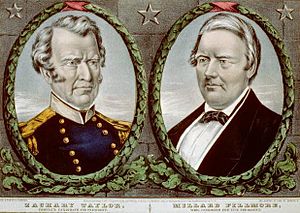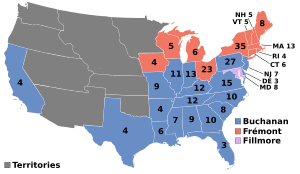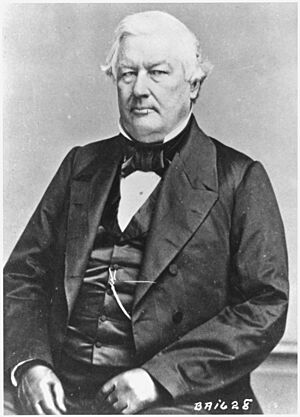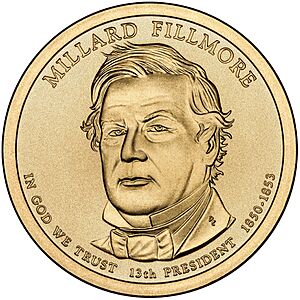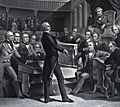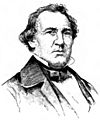Millard Fillmore facts for kids
Quick facts for kids
Millard Fillmore
|
|
|---|---|
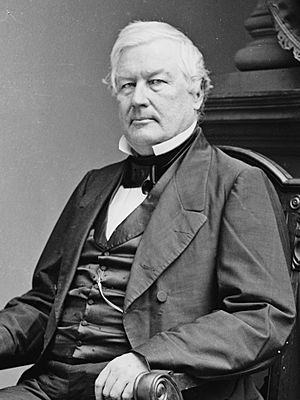
Portrait by Mathew Brady, c. 1855–1865
|
|
| 13th President of the United States | |
| In office July 9, 1850 – March 4, 1853 |
|
| Vice President | None |
| Preceded by | Zachary Taylor |
| Succeeded by | Franklin Pierce |
| 12th Vice President of the United States | |
| In office March 4, 1849 – July 9, 1850 |
|
| President | Zachary Taylor |
| Preceded by | George M. Dallas |
| Succeeded by | William R. King |
| 14th Comptroller of New York | |
| In office January 1, 1848 – February 20, 1849 |
|
| Governor | John Young Hamilton Fish |
| Preceded by | Azariah C. Flagg |
| Succeeded by | Washington Hunt |
| Chairman of the House Ways and Means Committee |
|
| In office March 4, 1841 – March 3, 1843 |
|
| Preceded by | John Winston Jones |
| Succeeded by | James I. McKay |
| Member of the U.S. House of Representatives from New York's 32nd district |
|
| In office March 4, 1837 – March 3, 1843 |
|
| Preceded by | Thomas C. Love |
| Succeeded by | William A. Moseley |
| In office March 4, 1833 – March 3, 1835 |
|
| Preceded by | Constituency established |
| Succeeded by | Thomas C. Love |
| Personal details | |
| Born | January 7, 1800 Moravia, New York, U.S. |
| Died | March 8, 1874 (aged 74) Buffalo, New York, U.S. |
| Resting place | Forest Lawn Cemetery Buffalo, New York, U.S. |
| Political party |
|
| Spouses |
Caroline McIntosh
(m. 1858) |
| Children |
|
| Parents |
|
| Profession |
|
| Signature | |
| Military service | |
| Branch/service |
|
| Years of service |
|
| Rank | |
| Commands | Union Continentals (New York Guard) |
| Battles/wars | American Civil War |
Millard Fillmore (January 7, 1800 – March 8, 1874) was the 13th president of the United States. He served from 1850 to 1853. He was the last president from the Whig Party.
Fillmore was born into a poor family in New York State. He worked hard to become a successful lawyer. He then became a politician in the Buffalo area. He was elected to the New York State Assembly in 1828. Later, he joined the U.S. House of Representatives in 1832.
Fillmore was elected the 12th vice president in 1848. He became president in July 1850 after President Zachary Taylor died. Fillmore helped pass the Compromise of 1850. This agreement tried to settle arguments about whether slavery could spread to new territories. He did not win the Whig nomination for president in 1852. Four years later, he ran for president with the Know Nothing Party and finished third.
Fillmore believed slavery was wrong. However, he thought the federal government could not end it. During his presidency, he supported opening trade with Japan. He also opposed France's plans for Hawaii. After his time as president, the Whig Party broke apart. Fillmore joined the Know Nothings. He focused on keeping the country united. During the American Civil War, he supported the Union. He was critical of President Abraham Lincoln's war policies. After the war, he supported President Andrew Johnson's Reconstruction plans.
Fillmore was also involved in community projects. He helped found the University of Buffalo in 1846. Historians often rank Fillmore as one of the less effective presidents. This is mainly because of his policies on slavery.
Contents
Early Life & Education
Millard Fillmore was born on January 7, 1800. He was born in a log cabin on a farm in Moravia, New York. His parents were Phoebe Millard and Nathaniel Fillmore. He was the second of eight children.
His parents were tenant farmers, meaning they rented land. The family was very poor when Millard was young. He had very little formal schooling. His father tried to get him to learn a trade. Millard worked as an apprentice to a clothmaker. He was unhappy because he only did simple tasks.
Millard wanted to learn more. He bought a share in a library and read many books. In 1819, he started studying at an academy. There, he met Abigail Powers, who he later married.
Later in 1819, his father helped him become a law clerk for Judge Walter Wood. Fillmore taught school to earn money. He also bought out his apprenticeship. In 1821, he became an adult at 21. He continued to study law. In 1823, he became a lawyer. He opened his own law practice in East Aurora.
Millard and Abigail married on February 5, 1826. They had two children: Millard Powers Fillmore and Mary Abigail Fillmore.
Political Career Begins
Fillmore became interested in politics. He joined the Anti-Masonic Party in the late 1820s. Many in this party opposed General Andrew Jackson, who was a Mason.
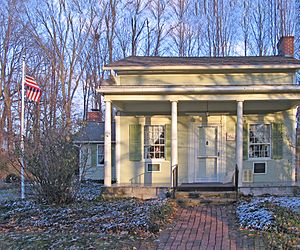
Fillmore was elected to the New York State Assembly in 1828. He served three one-year terms. He helped pass laws to end imprisonment for debt. By 1830, he moved his family to Buffalo. Buffalo was growing fast because of the Erie Canal. Fillmore helped draft the city's charter. He also helped found the Buffalo High School Association. He became a leading citizen in Buffalo.
Serving in Congress
In 1832, Fillmore was elected to the U.S. House of Representatives. He and others formed the Whig Party. This party opposed President Jackson. The Whigs wanted to grow the economy. They supported a national bank and federal projects like roads and canals.
Fillmore wanted to expand Buffalo's harbor. He also supported improving the Erie Canal. He became friends with Senator Daniel Webster from Massachusetts. Fillmore supported building infrastructure. He voted for navigation improvements and bridges.
Fillmore left Congress in 1835 but returned in 1837. He opposed President Martin Van Buren's economic plans. Fillmore believed government money should be used to develop the country. He thought it should not be kept in sub-treasuries.
Fillmore's relationship with Thurlow Weed, a powerful New York Whig leader, was often difficult. Weed supported William H. Seward for governor. Fillmore felt that Weed worked against him.
In 1841, Fillmore became chairman of the House Ways and Means Committee. This was a very important role. He helped create the Tariff of 1842. This law raised taxes on imported goods. It aimed to protect American manufacturing. Fillmore decided not to run for re-election in 1842. He wanted to return to his law practice in Buffalo.
Becoming a National Figure
After leaving Congress, Fillmore continued his law practice. He remained an important political figure. Some people wanted him to run for vice president in 1844. Others thought he should run for governor of New York. Fillmore wanted to be vice president.
However, Thurlow Weed worked to prevent Fillmore from getting the vice-presidential nomination. Weed wanted Fillmore to run for governor instead. Fillmore was nominated for governor against his wishes. He lost the election in 1844. He blamed his defeat on "foreign Catholics" and his weak stance on slavery.
In 1846, Fillmore helped found the University at Buffalo. He became its first leader, called chancellor. He served until his death. Fillmore opposed the annexation of Texas and the Mexican–American War. He saw the war as a way to expand slavery.
In 1847, Fillmore was elected Comptroller of New York. This job involved managing the state's finances. He was praised for his work. He helped stabilize the currency by requiring banks to hold bonds. This idea was later used by the federal government.
Election of 1848
Nomination for Vice President
In 1848, the Whig Party hoped to win the presidency. Many Whigs supported General Zachary Taylor, a hero from the Mexican War. However, some Northerners worried about electing a slaveholder. They also did not know Taylor's political views.
At the 1848 Whig National Convention, Taylor was nominated for president. To balance the ticket, Fillmore was chosen as the vice-presidential nominee. He was a good choice because he was from New York, a key state. He also had a strong record as a Whig. His rivalry with William H. Seward, who was known for anti-slavery views, made Fillmore more acceptable in the South.
Winning the Election
Fillmore stayed in Albany and did not make speeches. This was common for candidates back then. The 1848 election was a three-way race. The Democrats nominated Lewis Cass. The Free Soil Party, which opposed the spread of slavery, nominated former President Martin Van Buren.
Northerners thought Fillmore, from a free state, opposed slavery's spread. Southerners accused him of being an abolitionist. Fillmore denied this. He wrote that slavery was evil, but the federal government had no power over it.
The Taylor-Fillmore ticket won the election. New York's votes were very important. They won the popular vote and the Electoral College. The Free Soil Party showed the growing strength of the anti-slavery movement.
Vice Presidency (1849–1850)
Fillmore became vice president on March 5, 1849. He took his oath in the Senate Chamber. As vice president, he was also the president of the Senate.
President Taylor largely ignored Fillmore. Taylor consulted with Thurlow Weed and William H. Seward for federal jobs in New York. This reduced Fillmore's influence. Fillmore was frustrated by this.

A major issue during this time was slavery in the new territories. Taylor wanted California and New Mexico to be free states. Southerners were angry because they felt excluded. When Congress met in December 1849, there was a lot of disagreement.
Fillmore presided over intense debates in the Senate. On January 29, 1850, Henry Clay introduced his "Omnibus Bill". This bill aimed to settle the slavery issue. It would admit California as a free state. It would also organize new territories and ban the slave trade in Washington, D.C. A controversial part was strengthening the Fugitive Slave Act. This law made it easier to return escaped slaves.
Fillmore supported Clay's bill. He told President Taylor that he would vote for it if there was a tie in the Senate. Fillmore tried to keep peace among the senators.
Presidency (1850–1853)
Taking Office Amid Crisis
On July 9, 1850, President Taylor died suddenly. Fillmore was called to the White House. He received formal notice of Taylor's death. The next day, Fillmore took the oath of office as president.
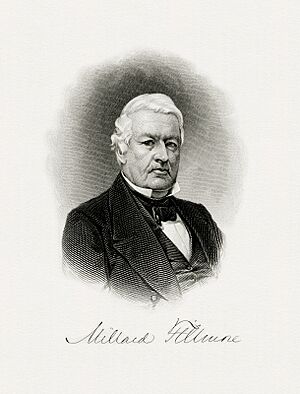
It was common for cabinet members to offer to resign when a new president took over. Fillmore accepted their resignations. He then appointed his own cabinet. His new cabinet members mostly supported the Compromise. His old law partner, Nathan K. Hall, became Postmaster General.
The country was still in crisis over slavery. Texas tried to claim land in New Mexico. Fillmore sent federal troops to the area. He warned Texas to keep the peace.
Clay's "Omnibus Bill" had stalled in Congress. Senator Stephen A. Douglas suggested breaking it into separate bills. Fillmore supported this idea. This led to the Compromise of 1850.
On August 6, 1850, Fillmore urged Congress to pass the Compromise. He warned about the conflict with Texas. The Compromise was passed as five separate bills. These included admitting California as a free state. They also set the boundary between New Mexico and Texas. The slave trade in Washington, D.C., was ended. The final status of slavery in New Mexico and Utah would be decided later. Fillmore signed all the bills. He waited two days to sign the Fugitive Slave Act until he knew it was constitutional.
Domestic Issues
The Fugitive Slave Act was very controversial. Southerners wanted it strictly enforced. Many Northerners found it unfair and offensive. It allowed escaped slaves to be returned without a trial. It also punished anyone who helped them. Fillmore believed he had to enforce the law as president. This law hurt his popularity and divided the Whig Party.
Fillmore supported building national infrastructure. He signed bills to help build the Illinois Central railroad. He also supported a canal at Sault Ste. Marie. In 1851, he rode the first train on the Erie Railroad with his cabinet. He gave speeches along the way, urging people to accept the Compromise.
Fillmore appointed one justice to the Supreme Court of the United States. He also appointed four judges to federal district courts.
Foreign Relations
Fillmore had two skilled Secretaries of State: Daniel Webster and Edward Everett. Fillmore made all the major decisions in foreign policy. He was very active in Asia and the Pacific.
He sent Commodore Matthew C. Perry on an expedition to Japan. Japan was mostly closed to foreign contact at the time. American merchants wanted to trade with Japan. They also wanted American sailors shipwrecked there to be treated fairly. Perry reached Japan in July 1853, after Fillmore's term ended.
Fillmore strongly opposed European influence in Hawaii. France wanted to take over Hawaii. Fillmore warned them that the United States would not allow it. France then backed down.
Fillmore also dealt with issues regarding Cuba. Many Southerners wanted Cuba to become an American slave territory. A Venezuelan adventurer named Narciso López led attempts to overthrow Spanish rule in Cuba. These attempts were called "filibustering." After one attempt, López and his followers were tried but found not guilty. The final expedition led to López's execution by the Spanish. This caused riots in New Orleans. Fillmore worked with Spain to resolve the crisis peacefully.
Election of 1852
As the election of 1852 approached, Fillmore considered running for a full term. Secretary Webster also wanted to be president. Fillmore initially said he would not seek a full term. However, he did not want the party to be taken over by Seward's group.
The 1852 Whig National Convention was held in June 1852. The main candidates were Fillmore, Webster, and General Winfield Scott. Thurlow Weed and William H. Seward supported Scott. The Democrats nominated Franklin Pierce. Pierce was a Northerner who sympathized with the South on slavery. This united the Democrats.
Fillmore was unpopular with Northern Whigs because he enforced the Fugitive Slave Act. But he had strong support from the South. The convention adopted a platform that supported the Compromise of 1850. Fillmore was willing to withdraw, but his supporters could not agree to support Webster. After many ballots, General Scott won the nomination. Scott lost the election to Pierce.
Fillmore's final months in office were quiet. He left office on March 4, 1853.
Life After the Presidency (1853–1874)
Fillmore was the first president to return to private life without being wealthy. He planned to practice law. However, his wife, Abigail, died shortly after he left office. She caught a cold at Pierce's inauguration and developed pneumonia. Fillmore was very sad. In 1854, his only daughter, Mary, also died from cholera.
Later Political Activity
In 1854, Fillmore ended his seclusion. He became involved in the debate over the Kansas–Nebraska Act. This law would allow new territories to decide on slavery themselves. Fillmore privately tried to gather Whig politicians to support him for president again.
The Whig Party was breaking apart. Many anti-slavery Whigs joined the new Republican Party. Fillmore did not feel at home there. In the 1850s, there was growing opposition to immigrants, especially Catholics. Several groups formed, including the Order of the Star Spangled Banner. This group became known as the Know Nothings. They were called "Know Nothings" because members were told to say they "knew nothing" about the group's activities.
Many of Fillmore's supporters joined the Know Nothings. Fillmore was encouraged by their success in the 1854 elections. In 1855, he wrote a letter warning about immigrant influence in elections. He then joined the Know Nothing order.
Fillmore traveled to Europe and the Middle East from 1855 to 1856. He met with Pope Pius IX in Rome. He was careful to avoid political controversy during his trip.
1856 Presidential Campaign
While Fillmore was in Europe, his allies arranged for him to get the Know Nothing presidential nomination. His running mate was Andrew Jackson Donelson. Fillmore returned in June 1856. He gave speeches thanking people for his welcome. He warned that electing the Republican candidate, John C. Frémont, could divide the country and lead to civil war.
Both Fillmore and the Democratic candidate, James Buchanan, agreed that slavery was mainly a state issue. Fillmore focused on keeping the Union together. He rarely spoke about immigration.
Fillmore's campaign struggled. Many former Whigs joined the Republican Party. The Know Nothings were not experienced in national campaigns. Buchanan won the election. Fillmore finished third, winning only Maryland's eight electoral votes. Many people who supported Fillmore voted for Buchanan instead. They feared that splitting the vote would help Frémont win.
Historians have debated Fillmore's connection to the Know Nothings. Some say he was not a true nativist. However, he did write a letter in 1855 that expressed concerns about immigrant influence.
Later Life & Death
Fillmore believed his political career ended with his 1856 defeat. His financial worries ended when he married Caroline McIntosh, a wealthy widow, in 1858. They bought a large house in Buffalo. They spent their time entertaining and supporting charities. He helped found the Buffalo General Hospital.
In the 1860 election, Fillmore voted for Stephen A. Douglas. After Abraham Lincoln was elected, Fillmore refused to get involved in the secession crisis. He felt he lacked influence. He criticized President Buchanan's inaction. He believed that states could not be forced to stay in the Union. However, he thought those who advocated leaving were traitors. When Lincoln visited Buffalo before his inauguration, Fillmore hosted him.
Once the American Civil War began, Fillmore supported Lincoln. He commanded the Union Continentals. This was a group of home guards for men over 45 in New York. They trained to defend Buffalo. They also performed ceremonial duties. They guarded Lincoln's funeral train in Buffalo.
In 1864, Fillmore gave a speech. He called for kindness towards the South after the war. He also spoke about the high cost of the war. The Lincoln administration saw this as an attack. Fillmore was criticized and called a "Copperhead" (a term for Northerners who opposed the war). This led to lasting negative feelings towards him. In the 1864 election, Fillmore supported George B. McClellan. He believed McClellan's plan for peace was best.
After Lincoln's assassination in 1865, Fillmore's house was vandalized. This was because it was not decorated for mourning. Fillmore later put black drapes in his windows. He supported President Andrew Johnson's Reconstruction policies. He believed the nation needed to heal quickly.
Fillmore spent most of his later life on community activities. He helped Buffalo get its first permanent art gallery.
Fillmore remained healthy until shortly before his death. He had a stroke in February 1874. He died on March 8, 1874, at age 74, after a second stroke. He was buried at Forest Lawn Cemetery in Buffalo.
Legacy & Historical View
Historians often rank Millard Fillmore as one of the less effective U.S. presidents. Many describe him as weak. This is largely because of how he handled the issue of slavery. Some historians say that presidents before the Civil War are often seen as lacking strong leadership.
Fillmore's name is sometimes used to describe presidents who are easily forgotten. One historian said Fillmore's "vision was myopic and his legacy is worse." However, others praise him for trying to keep the Union together. Some argue that he honorably enforced the laws, even unpopular ones like the Fugitive Slave Act.
His association with the Know Nothing Party has also hurt his reputation. But some argue he was not truly a nativist. They say he was more focused on uniting the country.
Some historians point out Fillmore's successes in foreign policy. He avoided war with Mexico and resolved disputes with other countries peacefully. He also took a strong stand against Texas's claims in New Mexico. He is praised for his firmness in his early months as president.
Fillmore and his wife, Abigail, created the first White House library. There are several memorials to Fillmore. His house in East Aurora still stands. There are also sites honoring his birthplace and boyhood home. A statue of Fillmore stands outside the Buffalo City Hall. The University at Buffalo, which he helped found, has buildings named after him. In 2010, the United States Mint released a dollar coin with Fillmore's image.
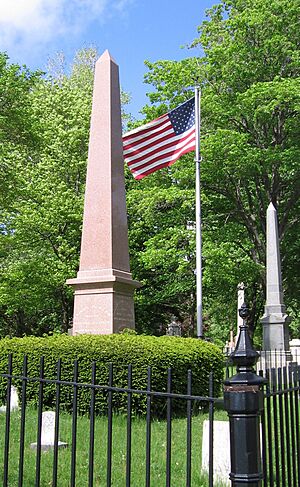
Images for kids
-
From a Peter F. Rothermel engraving: Vice President Fillmore (upper right) presides over the Compromise debates as Henry Clay takes the floor of the Old Senate Chamber. John C. Calhoun (seen in part standing just to Fillmore's right) and Daniel Webster (seated to the left of Clay) look on.
-
The house is designated a National Historic Landmark.
-
The DAR placed this plaque on the house in 1931.
See also
 In Spanish: Millard Fillmore para niños
In Spanish: Millard Fillmore para niños
- List of presidents of the United States
- List of vice presidents of the United States
- List of presidents of the United States by previous experience
- Presidents of the United States on U.S. postage stamps
- Fillmore Street, San Francisco, named for Millard Fillmore



